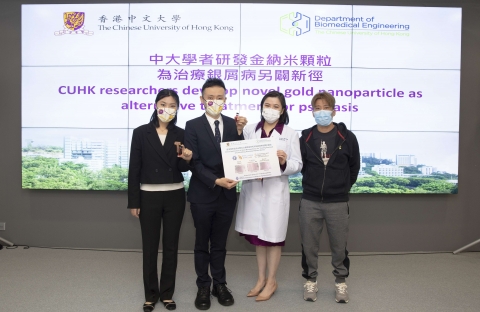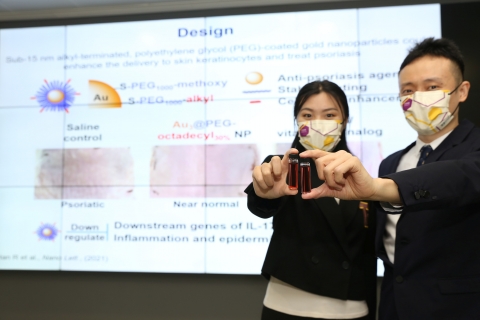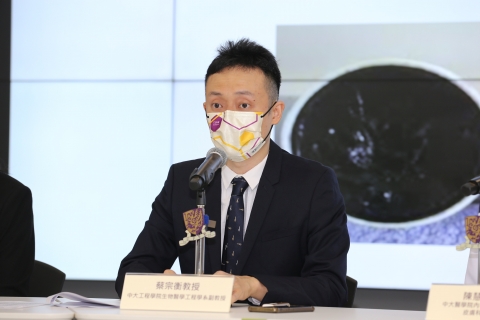Professor Jonathan Chung Hang CHOI, Associate Professor of the Department of Biomedical Engineering of the Faculty of Engineering at The Chinese University of Hong Kong (CUHK), and his team have developed a new gold nanoparticle as a self-therapeutic treatment for psoriasis. Devoid of steroids or biologics, this gold nanoparticle can downregulate the genes that are linked to epidermis hyperproliferation and inflammation and is an effective treatment for psoriasis. Based on data from mouse disease models, it treats psoriasis as effectively as a standard topical steroid and vitamin D analog-based therapy but without causing hair loss, skin wrinkling, or other side effects, therefore offering a simple, safe and effective alternative for treating psoriasis. The research findings have been recently published in Nano Letters. Psoriasis is a chronic, non-communicable inflammatory disease, characterised by red patches, and thick and silvery scales in the skin. Over 125 million people worldwide (approximately 2-3% of the population) suffer from psoriasis. Currently, there is no specific cure, and available treatment modalities have different side effects. For example, systemic administration of immunosuppressants may induce liver and kidney toxicity, topical application of steroids and vitamin D analogs may cause skin irritation, and ultraviolet light phototherapy may lead to skin cancer. Emerging biologics are costly and associated with an enhanced risk of infection. Psoriasis imposes a psychological and financial burden on patients, significantly reducing their quality of life. Bypassing the bottleneck for drug delivery to skin cells Researchers in the field have developed nanoparticles to load drugs, such as steroid or biologics for improving their delivery to the skin and reducing their toxicity, yet these drugs may not enter skin cells and accumulate in the skin for a sustained efficacy. Professor Choi and his team have designed a new class of nanoparticle, smaller than 15 nm in overall diameter, that bears a 3 nm gold core and an outer shell of polyethylene glycol strands modified with octadecyl chains. The polyethylene glycol shell prevents the gold cores from sweat-induced aggregation that disfavors their permeation to the epidermis, and the octadecyl chains promote the entry of the gold cores to the epidermal keratinocytes. After mixing the new nanoparticles with saline, the soaking gauze with nanoparticle solution was applied onto the psoriatic skin of mice for topical delivery. These nanoparticles successfully cross the thickened scales in the stratum corneum and then enter epidermal keratinocytes. Such a nano-material structure bypasses the bottleneck for drug delivery to skin cells. Direct application of gold nanoparticles for treating psoriasis and inhibiting psoriasis-related genes It has been revealed by many studies that the interleukin-17 signaling pathway is critical to the induction of psoriasis. The findings of Professor Choi’s team showed that the application of this new gold nanoparticle during the induction of psoriasis can prevent this disease and suppress genes in relation to the interleukin-17 signaling pathway. Applying this new gold nanoparticle after psoriasis is established can lead to obvious improvement in skin condition and reduced scales, with an efficacy similar to standard steroid and vitamin D analog-based therapy, but without inducing common side effects such as hair loss and skin wrinkling. For the first time, this study reveals the self-therapeutic value of gold nanoparticles in treating psoriasis, obviating the need for loading steroids or biologics. In addition, this new nanoparticle does not accumulate in major organs, nor does it cause long-term toxicity in skin and body. Professor Choi said, “We hope to continue our collaboration with the Faculty of Medicine at the University and perform clinical studies to validate the safety and efficacy of this new gold nanoparticle in humans in the future, so as to offer a new, safe and effective treatment for psoriasis patients. Moreover, our data indicates that this nanoparticle can downregulate multiple genes that are related to skin inflammation. We will explore its therapeutic potential for other skin diseases, such as the more prevalent eczema.” Other team members from CUHK include Ms. Alisa Ruifang HAN, PhD student of the Department of Biomedical Engineering of the Faculty of Engineering, Professor Paul Cheung Lung CHOI, Honorary Clinical Associate Professor of the Department of Anatomical and Cellular Pathology of the Faculty of Medicine, and other researchers from the University. This project received support from the Research Grants Council of Hong Kong, the CUHK Vice-Chancellor Discretionary Fund, Chow Yuk Ho Technology Centre for Innovative Medicine, and the Croucher Innovation Award by the Croucher Foundation. The full text of the research paper can be found at https://pubs.acs.org/doi/10.1021/acs.nanolett.1c02899. |
|




